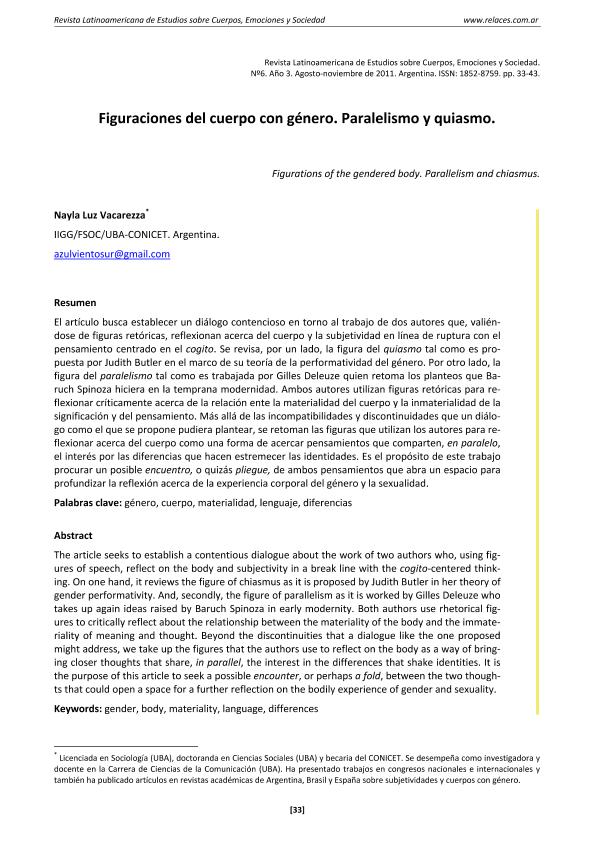Artículo
El artículo busca establecer un diálogo contencioso en torno al trabajo de dos autores que, valién‐ dose de figuras retóricas, reflexionan acerca del cuerpo y la subjetividad en línea de ruptura con el pensamiento centrado en el cogito. Se revisa, por un lado, la figura del quiasmo tal como es pro‐ puesta por Judith Butler en el marco de su teoría de la performatividad del género. Por otro lado, la figura del paralelismo tal como es trabajada por Gilles Deleuze quien retoma los planteos que Ba‐ ruch Spinoza hiciera en la temprana modernidad. Ambos autores utilizan figuras retóricas para re‐ flexionar críticamente acerca de la relación ente la materialidad del cuerpo y la inmaterialidad de la significación y del pensamiento. Más allá de las incompatibilidades y discontinuidades que un diálo‐ go como el que se propone pudiera plantear, se retoman las figuras que utilizan los autores para re‐ flexionar acerca del cuerpo como una forma de acercar pensamientos que comparten, en paralelo, el interés por las diferencias que hacen estremecer las identidades. Es el propósito de este trabajo procurar un posible encuentro, o quizás pliegue, de ambos pensamientos que abra un espacio para profundizar la reflexión acerca de la experiencia corporal del género y la sexualidad. The article seeks to establish a contentious dialogue about the work of two authors who, using fig‐ ures of speech, reflect on the body and subjectivity in a break line with the cogito‐centered think‐ ing. On one hand, it reviews the figure of chiasmus as it is proposed by Judith Butler in her theory of gender performativity. And, secondly, the figure of parallelism as it is worked by Gilles Deleuze who takes up again ideas raised by Baruch Spinoza in early modernity. Both authors use rhetorical fig‐ ures to critically reflect about the relationship between the materiality of the body and the immate‐ riality of meaning and thought. Beyond the discontinuities that a dialogue like the one proposed might address, we take up the figures that the authors use to reflect on the body as a way of bring‐ ing closer thoughts that share, in parallel, the interest in the differences that shake identities. It is the purpose of this article to seek a possible encounter, or perhaps a fold, between the two though‐ ts that could open a space for a further reflection on the bodily experience of gender and sexuality.
Figuraciones del cuerpo: paralelismo y quiasmo
Título:
Figurations of the gendered body: parallelism and chiasmus
Fecha de publicación:
08/2011
Editorial:
Consejo Nacional de Investigaciones Científicas y Técnicas. Centro de Investigaciones y Estudios sobre Cultura y Sociedad; Universidad Nacional de Córdoba
Revista:
Revista Latinoamericana de Estudios sobre Cuerpos, Emociones y Sociedad
ISSN:
1852-8759
Idioma:
Español
Tipo de recurso:
Artículo publicado
Clasificación temática:
Resumen
Palabras clave:
GÉNERO
,
CUERPO
,
LENGUAJE
,
DIFERENCIAS
Archivos asociados
Licencia
Identificadores
Colecciones
Articulos(SEDE CENTRAL)
Articulos de SEDE CENTRAL
Articulos de SEDE CENTRAL
Citación
Vacarezza, Nayla Luz; Figuraciones del cuerpo: paralelismo y quiasmo; Consejo Nacional de Investigaciones Científicas y Técnicas. Centro de Investigaciones y Estudios sobre Cultura y Sociedad; Universidad Nacional de Córdoba; Revista Latinoamericana de Estudios sobre Cuerpos, Emociones y Sociedad; 3; 6; 8-2011; 33-43
Compartir




